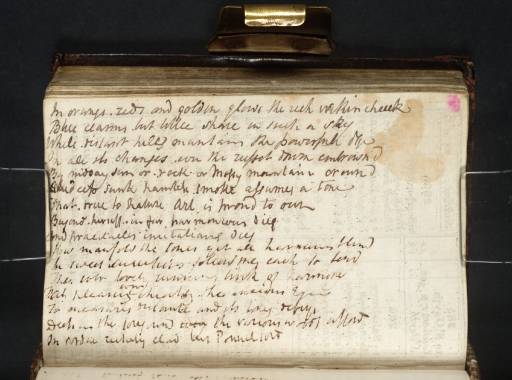Joseph Mallord William Turner Inscription by Turner: Draft of Poetry 1811
Joseph Mallord William Turner,
Inscription by Turner: Draft of Poetry
1811
Joseph Mallord William Turner 1775–1851
Folio 159 Verso:
Inscription by Turner: Draft of Poetry 1811
D08661
Turner Bequest CXXIII 156a
Turner Bequest CXXIII 156a
Inscribed by Turner in ink (see main catalogue entry) on white wove printing paper, 75 x 117 mm
Accepted by the nation as part of the Turner Bequest 1856
References
1909
A.J. Finberg, A Complete Inventory of the Drawings of the Turner Bequest, London 1909, vol.I, p.350, CXXIII 156a, as ‘Verses’.
1987
John Gage, J.M.W. Turner: ‘A Wonderful Range of Mind’, New Haven and London 1987, pp.195, 253 note 38.
1990
Frank Milner, J.M.W. Turner: Paintings in Merseyside Collections: Walker Art Gallery; Sudley Art Gallery; Williamson Art Gallery; Lady Lever Art Gallery; Liverpool University Art Gallery, Liverpool 1990, p.41 under no.19.
1990
Andrew Wilton and Rosalind Mallord Turner, Painting and Poetry: Turner’s ‘Verse Book’ and his Work of 1804–1812, exhibition catalogue, Tate Gallery, London 1990, pp.174–5.
The whole page is taken up with the following lines of verse:
In orange, reds and golden glows the rich welkin cheek
Blue charms but little shone in such a sky
While distant hills mantain the powerfull dye
In all its changes even the russet down embrownd
By midday sun or rock or mossy mountain crownd
And deep sunk hamlets smoke assumes a tone
That true to Nature Art is proud to own
Beyond herself in fair harmonious [?dies]
And practically imitations dies
How manfold [i.e. ‘manifold’] the tones yet all harm[...]us [i.e. ‘harmonious’] blend
In sweet succession following each to lend
The ever lovely running link of harmony
That pleasing [‘ever’ inserted above] cheating the anxious Eye
To measures distance and its lines defy,
Deep in the foreground <‘way’> the various [?woods] afford
In verdure richly clad lies [?Poppelford]1
Blue charms but little shone in such a sky
While distant hills mantain the powerfull dye
In all its changes even the russet down embrownd
By midday sun or rock or mossy mountain crownd
And deep sunk hamlets smoke assumes a tone
That true to Nature Art is proud to own
Beyond herself in fair harmonious [?dies]
And practically imitations dies
How manfold [i.e. ‘manifold’] the tones yet all harm[...]us [i.e. ‘harmonious’] blend
In sweet succession following each to lend
The ever lovely running link of harmony
That pleasing [‘ever’ inserted above] cheating the anxious Eye
To measures distance and its lines defy,
Deep in the foreground <‘way’> the various [?woods] afford
In verdure richly clad lies [?Poppelford]1
Interspersed with drawings and the printed pages of Coltman’s British Itinerary, sixty-nine pages of this sketchbook are given over wholly or partly to these verses which Turner intended as a commentary for publication with the Picturesque Views on the Southern Coast of England which he sketched on the 1811 West Country tour (see the introduction to the sketchbook). The first lines are on folio 18 verso (D08396), and the last on folio 207 verso (D08736; CXXIII 204a).
The previous passage, on folio 157 verso (D08657; CXXIII 154a), concludes a stormy, rocky Cornish coastal sequence with an indication of clearing skies, developed in the lush, lyrical imagery here. ‘Welkin’, a poetic word for the sky, had also been used on folios 130 verso and 138 verso (D08610, D08624; CXXIII 127a, 135a).
Although John Gage has suggested that the first few lines may relate to the sketch of Bridgwater immediately opposite on folio 160 recto (D08662; CXXIII 157), or more likely to the view of Minehead on folio 165 verso (D08672; CXXIII 162a) as interpreted in the sunny Southern Coast watercolour of the view,2 Minehead and Dunster Castle, Somersetshire, of about 1820 (Lady Lever Art Gallery, Port Sunlight),3 the setting for the whole passage is probably South Devon. Wilton and Turner give the last word as ‘Pennelford’, but by reading the double letters as ‘pp’ (allowing for Turner’s characteristic short or absent downstrokes) then ‘Poppelford’ seems intended, suggesting Newton Poppleford, near Sidmouth on the Exeter road. Exeter itself is mentioned in the next passage, on folio 162 verso (D08666; CXXIII 159a), while there are sketches of Sidmouth on folios 206 verso and 208 recto (D08734, D08737; CXXIII 203a, 205).
Technical notes:
There is a brown stain at the top right, which has come through from the recto of the sheet (D08660; CXXIII 156).
Matthew Imms
June 2011
How to cite
Matthew Imms, ‘Inscription by Turner: Draft of Poetry 1811 by Joseph Mallord William Turner’, catalogue entry, June 2011, in David Blayney Brown (ed.), J.M.W. Turner: Sketchbooks, Drawings and Watercolours, Tate Research Publication, December 2012, https://www

